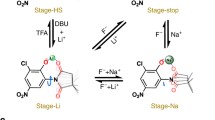Abstract
Ab initio calculations are employed to investigate nitrogen inversion as a configuration change that can supply an extremely useful switchable control mechanism for some complex systems. In this paper, the design of a new artificial rotary molecular machine based on nitrogen inversion is discussed. The introduced design of a molecular rotator is based on the reciprocating motion of a substituent due to the inversion phenomenon, leading to the rotary motion in the molecule. Since simple secondary amines easily face the inversion process at room temperature, aziridine is selected as the initial driver for the molecular motion. The most obvious finding from this study is that, following the displacement of the substituent attached to the aziridine nitrogen atom, two rotary motions occurr in the molecule, one clockwise and another counterclockwise with a 39.52° to 150.09° angle domain.
Similar content being viewed by others
References
A. Credi, Aust. J. Chem., 59, 157–169 (2006).
Y. B. Zheng, Q. Hao, Y.-W. Yang, B. Kiraly, I.-K. Chiang, and T. J. Huang, J. Nanophotonics, 4, 042501 (2010).
C. P. Mandl and B. König, Angew. Chem., Int. Ed., 43, 1622–1624 (2004).
T. Muraoka, K. Kinbara, and T. Aida, Nature, 440, 512/513 (2006).
K. Kinbara and T. Aida, Chem. Rev., 105, 1377–1400 (2005).
E. R. Kay, D. A. Leigh, and F. Zerbetto, Angew. Chem., Int. Ed., 46, 72–191 (2007).
R. Knorr, J. Ruhdorfer, J. Mehlstäubl, P. Böhrer, and D. S. Stephenson, Eur. J. Inorg. Chem., 126, 747–754 (1993).
A. J. Hough, Photochemical Control of Pyramidal Inversion and Photoactivation of Antimicrobial Agents, Department of Chemistry, University of Warwick; http://go.warwick.ac.uk/wrap/57507.
G. Park, S. Kim, and H. Kang, Bull. Korean Chem. Soc., 26, 1339 (2005).
R. D. Bach and G. J. Wolber, J. Org. Chem., 47, No. 2, 239–245 (1982).
D. Tanner, Angew. Chem., Int. Ed. Engl., 33, 599–619 (1994).
D. De Loera, F. Liu, K. N. Houk, and M. A. G. Garibay, J. Org. Chem., 78, No. 22, 11623–11626 (2013).
A. Ebrahimi, F. Deyhimi, and H. Roohi, J. Mol. Struct: THEOCHEM, 535, 247–256 (2001).
Author information
Authors and Affiliations
Corresponding author
Additional information
The text was submitted by the authors in English. Zhurnal Strukturnoi Khimii, Vol. 57, No. 3, pp. 484-487, March-April, 2016.
Original Russian Text © 2016 S. S. Gorgani, M. Samadizadeh.
Rights and permissions
About this article
Cite this article
Gorgani, S.S., Samadizadeh, M. Design of a new rotary molecular machine based on nitrogen inversion: a DFT investigation. J Struct Chem 57, 454–458 (2016). https://doi.org/10.1134/S0022476616030057
Received:
Published:
Issue Date:
DOI: https://doi.org/10.1134/S0022476616030057




